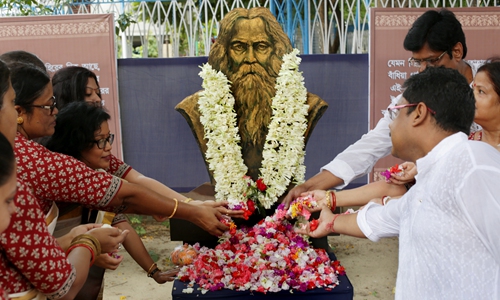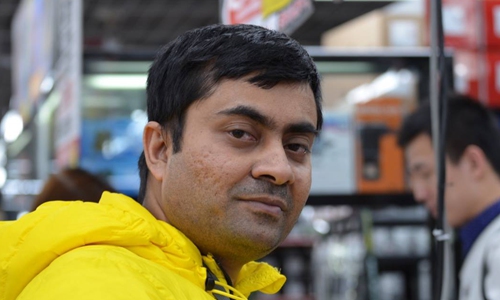Chinese, Indian artists and scholars celebrate iconic literati’s 159th birthday
By Shamim Zakaria Source:Global Times Published: 2020/5/11 17:40:49

Indian teachers and students offer a floral tribute to a statue of Rabindranath Tagore during a celebration of the Nobel laureate's birthday in Kolkata, India, on May 9, 2018. Photo: IC

Suvam Pal Photo: Courtesy of Suvam Pal
Seventy-nine years after his demise, Nobel laureate and multi-faceted polymath Rabindranath Tagore's creations continue to capture hearts with his belief in an international and borderless world. This ethos is clearly reflected in a collaborative micro-documentary as scholars and students from across the globe, including China, came together to commemorate the 159th anniversary of Tagore's birth.
Gitanjali, an ensemble of poetry, song, music, dance and art, was released in Beijing on Sunday. The first-of-its-kind film sees the participation of faculty members and students from China's Peking University, Tsinghua University, Communication University of China, Yunnan Minzu University, UK's University of Bath and India's Visva-Bharati and Doon University, as well as professionals from more than 10 different cities in India and the UK.
'Passion project'
Filmmaker Suvam Pal, a Beijing-based author and media professional, calls his documentary a "passion project" that also celebrates 70 years of China-India diplomatic ties as Tagore "played a pivotal role in building a golden bridge between the two ancient civilizations and neighbors for ages."
"I wanted to showcase an unexplored aspect of our cultural ties. So, it's an amalgamation of my love for Tagore and my passion for building a tiny cultural bridge between the two countries," said Suvam, adding that the literature luminary consolidated the bonding that occurred between China and India a few decades before the official Sino-Indian diplomatic channel was established in 1950.
Enchanted by the great Chinese civilization and its various intangible heritages, Suvam, who has been a Beijing dweller for the past four years, said the encouragement and inquisitiveness of several of his Chinese friends and acquaintances, including artists, impelled him to bring the film into fruition.
"I have a high regard and respect for Chinese scholars and artists as they represent a great civilization that has lasted for thousands of years. They are unique and top-notch. I must say that I have been fortunate to receive their gracious and wholehearted help for the collaboration, and I guess it's their love and respect for Tagore that helped me to bring the best out of them."
Echoing similar accolades, music composer Sarit Das regards this as a "rare experience" of collaboration with Chinese artists and musicians.
"They learned so fast the temperament of this music that it was really encouraging for me. I found Chinese are always curious about Indian art and culture and take very much interest to work with me whenever I put any idea or project," said Das.
A guest teacher at China's prestigious Central Conservatory of Music in Beijing and an eminent percussionist, Das has rendered and supervised the music melange, and he is also the executive producer of this documentary.
The documentary sees Chinese students and scholars paying their heartfelt tributes in Tagore's mater lingua Bengali, while their Indian counterparts exhibit their reverence for the beloved bearded bard in Chinese.
Overcoming COVID-19
However, from conceptualization to execution, and bringing together 25 different performers scattered across three countries took a mammoth effort.
"Due to the COVID-19 situation, my entire cast and crew were scattered in different parts of China and India," Suvam explained.
"It was easier said than done as we couldn't send a camera crew to the 25 different artists/performers' locations due to the current situation," he said, adding that different social media messaging APPs and various modern modes of communication helped to overcome the hurdles of distance.
Commending the stellar role of Gitanjali's crew members, Suvam said each of them was highly enthusiastic about the project and went out of the way to do their bit. From a technical perspective, it was challenging for Das to mix the separately-sent vocal and music tracks into one song and editing various scattered video feeds into a visual sequence was also challenging for the editor, Showbhik Chowdhury.
"Anyway, as they say, all's well that ends well," Suvam said, sighing.
The unique musical rendition of Gitanjali is a fusion of a slew of traditional Chinese instruments such as pipa, guzheng and yangqin, alongside popular Western instruments like the piano and guitar, with a reverberation of classical Indian instruments the sitar, tabla and esraj. Beijing-based Bharatnatyam choreographer Jin Shanshan specially created her dance moves following the style of Rabindra Nritya, a dance genre from Santiniketan, India, for the documentary, while Indian dancer and Tsinghua University scholar Reshmita Nath danced to a Tagore classic sung by a group of Chinese students studying Bengali.
"This was my first attempt at Tagore music and dance. I was extremely happy to contribute," said Jin Shanshan.
Some parts of a poem from one of Tagore's anthologies, Stray Birds, was recited in Chinese by Deborshmi Nath, a 9-year-old Indian student from Beijing, while 91-year-old Tan Chung, an eminent historian and son of the late Tan Yun-Shan, founder of Cheena Bhavan in Visva-Bharati, Santiniketan, India, shared pearls of wisdom on the Indian literature colossus.
"Rhythmic skill and improvisation is a very new and interesting concept for Chinese audiences as well as students and performers. They appreciate our music learning system and how we remember all the music by heart," said Das, adding that he thoroughly enjoys performing for Chinese audiences.
"I have taken more than 100 musicians from India to China for performances in different Chinese cities. There are many things we can learn from the Chinese people. It's most important to share the ideas between common people of the two countries or civilizations."
Newspaper headline: Remembering Tagore